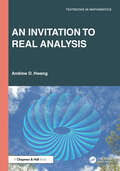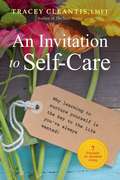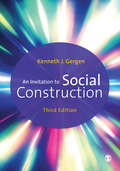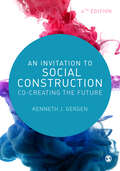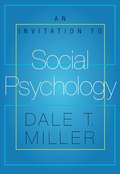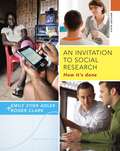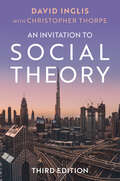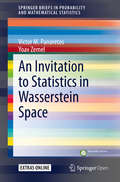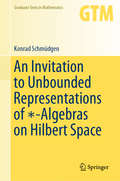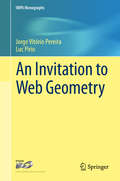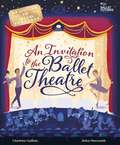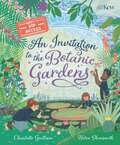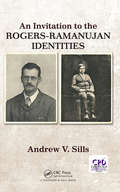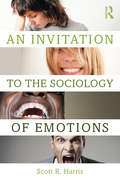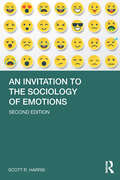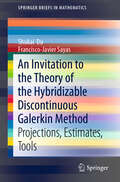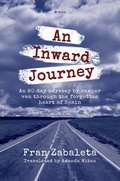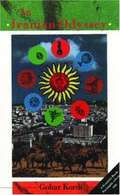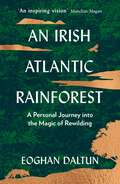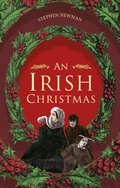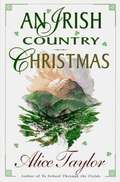- Table View
- List View
An Invitation to Real Analysis (Textbooks in Mathematics)
by Andrew D. HwangAdopting a student-centered approach, this book anticipates and addresses the common challenges that students face when learning abstract concepts like limits, continuity, and inequalities. The text introduces these concepts gradually, giving students a clear pathway to understanding the mathematical tools that underpin much of modern science and technology. In addition to its focus on accessibility, the book maintains a strong emphasis on mathematical rigor. It provides precise, careful definitions and explanations while avoiding common teaching pitfalls, ensuring that students gain a deep understanding of core concepts, and blending algebraic and geometric perspectives to help students see the full picture. The theoretical results presented in the book are consistently applied to practical problems. By providing a clear and supportive introduction to real analysis, the book equips students with the tools they need to confidently engage with both theoretical mathematics and its wide array of practical applications.Features Student-Friendly Approach making abstract concepts relatable and engaging Balanced Focus combining algebraic and geometric perspectives Comprehensive Coverage: Covers a full range of topics, from real numbers and sequences to metric spaces and approximation theorems, while carefully building upon foundational concepts in a logical progression Emphasis on Clarity: Provides precise explanations of key mathematical definitions and theorems, avoiding common pitfalls in traditional teaching Perfect for a One-Semester Course: Tailored for a first course in real analysis Problems, exercises and solutions
An Invitation to Self-Care: Why Learning to Nurture Yourself is the Key to the Life You've Always Wanted
by Tracey CleantisToo often, we settle for the notion that self-care means giving ourselves treats and rewards for good behavior. But it’s so much more than that. Welcome to the self-care revolution! A day of indulgence at a spa—or at home on the couch—might help us unwind and feel temporarily renewed, but is that all there is to self-care? In this book Tracey Cleantis changes the dialogue and shows why real self-care is more than just routine self-indulgence—it’s a lifelong practice that’s essential to finding fulfillment and joy. An Invitation to Self-Care uncovers seven principles for care that are rooted in self-empowerment and self-knowledge. Through personal stories and observations, exercises and quizzes, and interviews with experts and everyday people, Tracey invites you to consider self-care across your relationships, finances, spiritual and professional life—and more. By accepting who we are, what we need, and how those needs evolve over time, we create space for self-care’s transformational magic in our lives. In fact, an authentic self-care practice is the secret to the life you’ve always wanted.
An Invitation to Social Construction
by Kenneth J. GergenThis new edition of Kenneth J. Gergen’s celebrated text An Invitation to Social Construction is now even more accessible for students, offering a clear and thorough introduction to one of the most significant movements in contemporary social science. The Third Edition includes: updates reflecting the many new developments in theory, research, and practice a more student-friendly, personal writing style three new chapters on education, and therapy and health care, and organizations key insights into how social construction can help support you in your research projects, from start to finish. An Invitation to Social Construction is the must-read text for all social science students, academics and practitioners wishing to learn about social constructionism, along with the forms of inquiry and practice central to its impact.
An Invitation to Social Construction
by Kenneth J. Gergen`An Invitation to Social Construction is a rewarding read for newcomers to social constructionist thinking and for those well acquainted with this view. ' - New Therapist `Kenneth Gergen's book, An Invitation to Social Construction, may be the best introduction to the scholarship on social constructionism available today - but that's not all it is. It is also an inspiring and optimistic vision of what we can do to create better lives for ourselves. . . . Gergen's book is a key book for you to read' - Lois Shawver From a leading figure in the field, this introductory text forms an elegant overview of social constructionism that is at once wide-ranging and accessible. In this landmark work Kenneth Gergen charts the background to the social constructionist movement and outlines the major debates, topics and issues in a way that is at once profound yet highly readable. It is an interdisciplinary tour de force that will influence the development of teaching, research and social practice for years to come.
An Invitation to Social Construction: Co-Creating the Future
by Kenneth J. GergenThis fully updated fourth edition of Gergen’s An Invitation to Social Construction introduces you to a key theoretical movement in contemporary social science through a wide range of multidisciplinary examples. The fourth edition includes: wider consideration of contemporary global challenges, increased coverage of media, digital culture, and relevant political issues, updated real-world examples of social constructionist theory in action, in research, education, therapy, organizations, and peace building. This book brings together complex theories that inform and critically build upon social constructionism, such as narratology, deconstruction, dialogism, positivism, and post-structuralism, in a way that is accessible for students and researchers alike. It is a vital resource for those studying social psychology and critical social psychology who are looking for a comprehensive guide to one of the core topics in the field. Kenneth J Gergen is Senior Research Professor in Psychology at Swarthmore College, and the President of the Taos Institute.
An Invitation to Social Construction: Co-Creating the Future
by Kenneth J. GergenThis fully updated fourth edition of Gergen’s An Invitation to Social Construction introduces you to a key theoretical movement in contemporary social science through a wide range of multidisciplinary examples. The fourth edition includes: wider consideration of contemporary global challenges, increased coverage of media, digital culture, and relevant political issues, updated real-world examples of social constructionist theory in action, in research, education, therapy, organizations, and peace building. This book brings together complex theories that inform and critically build upon social constructionism, such as narratology, deconstruction, dialogism, positivism, and post-structuralism, in a way that is accessible for students and researchers alike. It is a vital resource for those studying social psychology and critical social psychology who are looking for a comprehensive guide to one of the core topics in the field. Kenneth J Gergen is Senior Research Professor in Psychology at Swarthmore College, and the President of the Taos Institute.
An Invitation to Social Psychology
by Dale T. MillerWhy does what others think of us matter so much? Why do people act in ways that seem to conflict with their stated beliefs? How does being part of a group impact our behavior and reactions to events and ideas? In this easy to understand book, the author uses experiences from everyday life to show readers how social psychology works. Ideas presented here are accessible both for people new to psychology as well as students and therapists.
An Invitation to Social Research: How It's Done (Mindtap Course List Series)
by Roger Clark Emily Stier AdlerWith real-world examples and an emphasis on ethics throughout, this book combines balanced coverage of quantitative and qualitative methods of social research with a unique “behind the scenes” approach. Built on focal research pieces and excerpts from real research projects, chapters present the insights, perspectives, and challenges of actual researchers in the field. The result is a comprehensive resource that guides readers step by step through the many stages of social research-from selecting a researchable question and designing a study to choosing the best method of data analysis for a particular study-and prepares them for the ethical issues and problems that they may face along the way. Reflecting the latest practices from the field, the book also integrates a greater emphasis on research focusing on evidence-based programs and policy.
An Invitation to Social Theory
by David InglisSocial theory is a crucial resource for the social sciences. It provides rich insights into how human beings think and act and how contemporary social life is constructed. But often the key ideas of social theorists are expressed in highly technical and difficult language that can hide more than it reveals. The new edition of this popular book continues to cut to the core of what social theory is about. Wide-ranging in scope and coverage, it is concise in presentation and free from jargon. Covering key themes and schools of thought from the classical thinkers up to the present, the third edition features a new chapter dedicated to post-colonial sociological theory. With updated literature and examples throughout, the book also includes refreshed pedagogical features to connect theory to readers’ own life experiences. Showing why social theory matters, and why it is of far-reaching social and political importance, the book is ideal for readers seeking a clear, crisp mapping of a complex but very rewarding area.
An Invitation to Statistics in Wasserstein Space (SpringerBriefs in Probability and Mathematical Statistics)
by Victor M. Panaretos Yoav ZemelThis open access book presents the key aspects of statistics in Wasserstein spaces, i.e. statistics in the space of probability measures when endowed with the geometry of optimal transportation. Further to reviewing state-of-the-art aspects, it also provides an accessible introduction to the fundamentals of this current topic, as well as an overview that will serve as an invitation and catalyst for further research. Statistics in Wasserstein spaces represents an emerging topic in mathematical statistics, situated at the interface between functional data analysis (where the data are functions, thus lying in infinite dimensional Hilbert space) and non-Euclidean statistics (where the data satisfy nonlinear constraints, thus lying on non-Euclidean manifolds). The Wasserstein space provides the natural mathematical formalism to describe data collections that are best modeled as random measures on Euclidean space (e.g. images and point processes). Such random measures carry the infinite dimensional traits of functional data, but are intrinsically nonlinear due to positivity and integrability restrictions. Indeed, their dominating statistical variation arises through random deformations of an underlying template, a theme that is pursued in depth in this monograph.
An Invitation to Unbounded Representations of ∗-Algebras on Hilbert Space (Graduate Texts in Mathematics #285)
by Konrad SchmüdgenThis textbook provides an introduction to representations of general ∗-algebras by unbounded operators on Hilbert space, a topic that naturally arises in quantum mechanics but has so far only been properly treated in advanced monographs aimed at researchers. The book covers both the general theory of unbounded representation theory on Hilbert space as well as representations of important special classes of ∗-algebra, such as the Weyl algebra and enveloping algebras associated to unitary representations of Lie groups. A broad scope of topics are treated in book form for the first time, including group graded ∗-algebras, the transition probability of states, Archimedean quadratic modules, noncommutative Positivstellensätze, induced representations, well-behaved representations and representations on rigged modules.Making advanced material accessible to graduate students, this book will appeal to students and researchers interested in advanced functional analysis and mathematical physics, and with many exercises it can be used for courses on the representation theory of Lie groups and its application to quantum physics. A rich selection of material and bibliographic notes also make it a valuable reference.
An Invitation to Web Geometry (IMPA Monographs #2)
by Jorge Vitório Pereira Luc PirioThis book takes an in-depth look at abelian relations of codimension one webs in the complex analytic setting. In its classical form, web geometry consists in the study of webs up to local diffeomorphisms. A significant part of the theory revolves around the concept of abelian relation, a particular kind of functional relation among the first integrals of the foliations of a web. Two main focuses of the book include how many abelian relations can a web carry and which webs are carrying the maximal possible number of abelian relations. The book offers complete proofs of both Chern's bound and Trépreau's algebraization theorem, including all the necessary prerequisites that go beyond elementary complex analysis or basic algebraic geometry. Most of the examples known up to date of non-algebraizable planar webs of maximal rank are discussed in detail. A historical account of the algebraization problem for maximal rank webs of codimension one is also presented.
An Invitation to the Ballet Theatre
by Charlotte GuillainGrab your very own VIP access pass and enter the wonderful world of the ballet theatre. Have you ever wondered how ballet dancers stay strong and avoid injury? Or how the magical scenes on stage are created by the set department? Step behind the scenes of the ballet theatre with your very own access-all-areas invitation to find out.Discover how stunning costumes are designed and see the thousands of shoes stored in the shoe room. Watch the dancers put on dramatic makeup, elaborate wigs and headdresses to create their characters. Discover the magic and wonder of performance night as the dancers prepare to dance Swan Lake. As you turn the pages you'll read the stories of other famous ballets such as The Nutcracker and The Firebird.With beautifully intricate illustrations, you'll discover more wonderful details each time you return.
An Invitation to the Botanic Gardens
by Charlotte GuillainGrab your very own VIP access pass and explore the incredible Botanic Gardens.Have you ever wondered what goes on at the Botanic Gardens? It's not all planting and pruning. In fact, the team have a planet-saving mission on their hands – and you can help. Step off the path and follow the Garden crew who will show you behind the scenes of the Botanic Gardens with your very own access-all-areas invitation.Find out how scientists research plants that can cure diseases, watch workers wading in the waterlily pond, and discover the secrets of seeds. Find out why samples of rare and endangered plants are stored in the Herbarium and leave no leaf unturned in the tropical glasshouse. Discover insect-eating plants, zombie fungus, plants pretending to be pebbles, and more.As you turn the pages you'll learn about the importance of insects, the impact of climate change and how plants grow. With beautiful, lush illustrations, you'll discover more wonderful details each time you return to the gardens.Three large gatefolds open up to reveal even more information.
An Invitation to the Rogers-Ramanujan Identities (Chapman & Hall/CRC Monographs and Research Notes in Mathematics)
by Andrew V. SillsThe Rogers--Ramanujan identities are a pair of infinite series—infinite product identities that were first discovered in 1894. Over the past several decades these identities, and identities of similar type, have found applications in number theory, combinatorics, Lie algebra and vertex operator algebra theory, physics (especially statistical mechanics), and computer science (especially algorithmic proof theory). Presented in a coherant and clear way, this will be the first book entirely devoted to the Rogers—Ramanujan identities and will include related historical material that is unavailable elsewhere.
An Invitation to the Sociology of Emotions
by Scott R. HarrisUnique in its approach, Invitation to the Sociology of Emotions treats neophytes as its primary audience, giving students a brief, but thorough, introduction to the sociology of emotions. Including research examples, exercises, and lists of further reading, this text explains as clearly as possible some of the most interesting theoretical concepts that animate sociological research on emotions.
An Invitation to the Sociology of Emotions
by Scott R. HarrisUnique in its approach, An Invitation to the Sociology of Emotions treats neophytes as its primary audience, giving students a brief, but thorough, introduction to the sociology of emotions. Including research examples, exercises, and lists of further reading, this text explains as clearly as possible some of the most interesting theoretical concepts that animate sociological research on emotions. In this new edition, the author updates the volume with recent research on emotion management, emotional labor, and emotions in social media.
An Invitation to the Table: Embracing the Gift of Hospitality
by Michelle LazurekJesus spent a chunk of his ministry eating and drinking with the "sinners and tax collectors" of the world. If we strive to be more like Jesus, shouldn't we do more of what he did?Hospitality involves more than the domesticated event we have grown accustomed to practicing. It is an embodiment of all the Christian life stands for: a gesture of love, opening up our hearts and lives, and sacrificing luxury and security for the chance to display God's glory. To receive hospitality from others is an invitation to receive God's transformative power to work in their lives.Readers will ask themselves these questions:* What is hospitality? * Is it something I am, or something I do? * How do I offer my life as a gesture of hospitality? * What are some practical ways for me to display and receive hospitality?
An Invitation to the Theory of the Hybridizable Discontinuous Galerkin Method: Projections, Estimates, Tools (SpringerBriefs in Mathematics)
by Francisco-Javier Sayas Shukai DuThis monograph requires basic knowledge of the variational theory of elliptic PDE and the techniques used for the analysis of the Finite Element Method. However, all the tools for the analysis of FEM (scaling arguments, finite dimensional estimates in the reference configuration, Piola transforms) are carefully introduced before being used, so that the reader does not need to go over longforgotten textbooks. Readers include: computational mathematicians, numerical analysts, engineers and scientists interested in new and computationally competitive Discontinuous Galerkin methods. The intended audience includes graduate students in computational mathematics, physics, and engineering, since the prerequisites are quite basic for a second year graduate student who has already taken a non necessarily advanced class in the Finite Element method.
An Inward Journey: An 80-day odyssey by camper van through the forgotten heart of Spain
by Fran ZabaletaTHE STORY OF AN EXTRAORDINARY JOURNEY BY CAMPER VAN THROUGH THE FORGOTTEN HEART OF SPAIN. Do I really know my own country? That's what I asked myself a year ago ... and the answer surprised me. Yes, I had been to many locations. I was very familiar with the outer edges of the peninsula, but the interior was a huge black hole pierced here and there by the lights of some city. So I set out to remedy it. I bought a van adapted as a home and I went to explore the interior of Spain. For eighty days I visited villages, castles, natural parks and archaeological sites, talked with people, researched a thousand stories and looked out into a world that was curiously familiar and, at the same time, completely unknown. The result is in your hands: an approach to the history, geography and present day realities of a country which is much larger, richer and more complex than we were ever told. A country that overflows with a rich heritage and an archaeological, historical and cultural wealth, full of amazing nooks and crannies, but also depopulated and lonely. A deeply beautiful country that is truly worth the effort of exploring in depth, getting lost in its innermost recesses and diving into its extraordinary past. Will you come with me on a voyage through this forgotten Spain?
An Iranian Odyssey
by Gohar KordiFrom the Book Jacket: Gohar Kordi was born in a small Kurdish village in Iran. At the age of four, she became blind. She writes of her growing up in the country, the family's move to Tehran and her personal struggle to get an education and become the first woman student at the university. Compelling, with a quiet, hypnotic power, An Iranian Odyssey is an autobiography that reveals its belief that adversity can be overcome.
An Irish Atlantic Rainforest: A Personal Journey into the Magic of Rewilding
by Eoghan DaltunAn Post Irish Book Award Winner'An inspiring vision' Manchán Magan'The stories are absorbing, the writing charismatic and the ideas thought-provoking' Irish IndependentOn the Beara peninsula in West Cork, a temperate rainforest flourishes. It is the life work of Eoghan Daltun, who had a vision to rewild a 73-acre farm he bought, moving there from Dublin with his family in 2009. An Irish Atlantic Rainforest charts that remarkable journey. Part memoir, part environmental treatise, as a wild forest bursts into life before our eyes, we're invited to consider the burning issues of our time: climate breakdown, ecological collapse, and why our very survival as a species requires that we urgently and radically transform our relationship with nature. Powerfully descriptive, lovingly told, An Irish Atlantic Rainforest presents an enduring picture of the regenerative force of nature, and how one Irishman let it happen.
An Irish Atlantic Rainforest: A Personal Journey into the Magic of Rewilding
by Eoghan DaltunAn Post Irish Book Award Winner'An inspiring vision' Manchán Magan'The stories are absorbing, the writing charismatic and the ideas thought-provoking' Irish IndependentOn the Beara peninsula in West Cork, a temperate rainforest flourishes. It is the life work of Eoghan Daltun, who had a vision to rewild a 73-acre farm he bought, moving there from Dublin with his family in 2009. An Irish Atlantic Rainforest charts that remarkable journey. Part memoir, part environmental treatise, as a wild forest bursts into life before our eyes, we're invited to consider the burning issues of our time: climate breakdown, ecological collapse, and why our very survival as a species requires that we urgently and radically transform our relationship with nature. Powerfully descriptive, lovingly told, An Irish Atlantic Rainforest presents an enduring picture of the regenerative force of nature, and how one Irishman let it happen.
An Irish Christmas
by Stephen NewmanThis book is a compendium of material, in English and Irish, on the festival of Christmas from the manuscripts of the National Folklore Collection recalling how Christmas was celebrated in the nineteenth and early twentieth century in all its regional diversity. The book begins with accounts of the Christmas preparations, before moving through Christmas Eve, with its fasting, feasting and a multitude of superstitions, Christmas Day, with its focus on the home and family, and on to the accounts of the communal celebration of St Stephen's Day with Wren Boys, games and hunting. Moving towards New Year's Day, the book recalls the optimism and fear associated with a transitional time when omens for the coming year were keenly observed, and finally concludes with accounts of the Little Christmas, also known as the Women's Christmas, celebrated on 6 January, and at which point the twelve-day festival comes to a close.
An Irish Country Christmas
by Alice TaylorIn this holiday gift edition, Alice Taylor returns to share the warm glow of a child's Yuletide celebration. Her tales of the season and the Irish countryside sparkle with magic. [From The inside dust jacket Flaps:] "The magic of Christmas was out in the moonlit haggard with the cattle and down the fields with the sheep but most of all it was here in the holly-filled kitchen with the little battered crib under the tree and the tall candle lighting in the window. The candle was the light of Christmas and the key that opened the door into the holy night." Beloved by readers on both sides of the Atlantic for her warmly remembered tales of Irish childhood, Alice Taylor now returns to reacquaint us with the joyful glow of a child’s Yuletide celebration in An Irish Country Christmas. In these pages she conveys, as no other author can, the delight that lies in every detail of the festive season for a young child. Her Irish countryside is like an archetype of everyone’s ideal Christmas landscape: a world where the season came with holly bundles and real geese to capture for the holiday dinner. Most of all, her storytelling reminds us of the unsentimental, wondrous innocence of youth, where every snow-dusted corner holds a surprise, and the lighting of the Christmas candle marks the commencement of magic. If Charles Dickens had written from rural Ireland instead of
